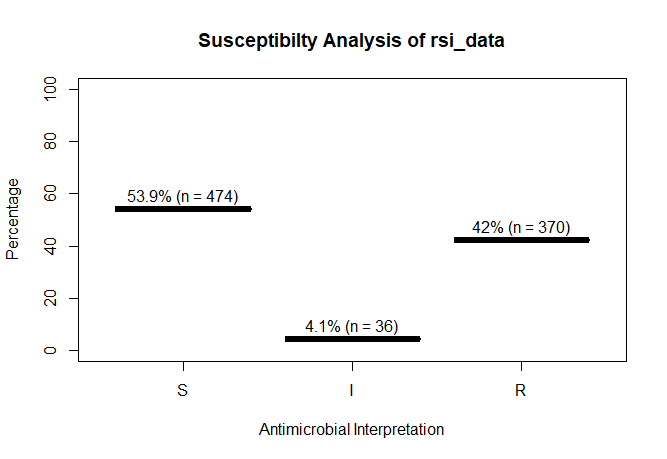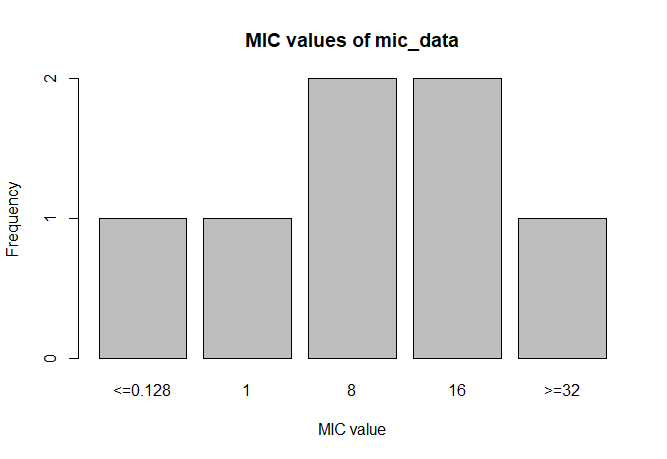AMR
An R package to simplify the analysis and prediction of Antimicrobial Resistance (AMR).
This R package was created for academic research by PhD students of the Faculty of Medical Sciences of the University of Groningen and the Medical Microbiology & Infection Prevention (MMBI) department of the University Medical Center Groningen (UMCG). See Authors.
Why this package?
This R package contains functions to make microbiological, epidemiological data analysis easier. It allows the use of some new classes to work with MIC values and antimicrobial interpretations (i.e. values S, I and R).
With AMR you can also:
- Create frequency tables with the
freqfunction - Conduct AMR analysis with the
rsifunction, that can also be used with thedplyrpackage (e.g. in conjunction withsummarise) to calculate the resistance percentages (and even co-resistance) of different antibiotic columns of a table - Predict antimicrobial resistance for the nextcoming years with the
rsi_predictfunction - Apply EUCAST rules to isolates with the
EUCAST_rulesfunction - Identify first isolates of every patient using guidelines from the CLSI (Clinical and Laboratory Standards Institute) with the
first_isolatefunction - Translate antibiotic codes from the lab (like
"AMOX") or the WHO (like"J01CA04") to trivial names (like"amoxicillin") with theabnamefunction
With the MDRO function (abbreviation of Multi Drug Resistant Organisms), you can check your isolates for exceptional resistance with country-specific guidelines or EUCAST rules. Currently guidelines for Germany and the Netherlands are supported. Please suggest addition of your own country here: https://github.com/msberends/AMR/issues/new.
This package contains an example data set septic_patients, consisting of 2000 isolates from anonymised septic patients between 2001 and 2017.
How to get it?
This package is available on CRAN and also here on GitHub.
From CRAN (recommended)
-
In RStudio (recommended):
- Click on
Toolsand thenInstall Packages... - Type in
AMRand press Install
- Click on
-
install.packages("AMR")
-
In Exploratory.io:
- (Exploratory.io costs $40/month but the somewhat limited Community Plan is free for students and teachers, click here to enroll)
- Start the software and log in
- Click on your username at the right hand side top
- Click on
R Packages - Click on the
Installtab - Type in
AMRand press Install - Once it’s installed it will show up in the
User Packagessection under thePackagestab.
From GitHub (latest development version)
install.packages("devtools")
devtools::install_github("msberends/AMR")
How to use it?
# Call it with:
library(AMR)
# For a list of functions:
help(package = "AMR")
Overwrite/force resistance based on EUCAST rules
This is also called interpretive reading.
before <- data.frame(bactid = c("STAAUR", # Staphylococcus aureus
"ENCFAE", # Enterococcus faecalis
"ESCCOL", # Escherichia coli
"KLEPNE", # Klebsiella pneumoniae
"PSEAER"), # Pseudomonas aeruginosa
vanc = "-", # Vancomycin
amox = "-", # Amoxicillin
coli = "-", # Colistin
cfta = "-", # Ceftazidime
cfur = "-", # Cefuroxime
stringsAsFactors = FALSE)
before
# bactid vanc amox coli cfta cfur
# 1 STAAUR - - - - -
# 2 ENCFAE - - - - -
# 3 ESCCOL - - - - -
# 4 KLEPNE - - - - -
# 5 PSEAER - - - - -
# Now apply those rules; just need a column with bacteria ID's and antibiotic results:
after <- EUCAST_rules(before)
after
# bactid vanc amox coli cfta cfur
# 1 STAAUR - - R R -
# 2 ENCFAE - - R R R
# 3 ESCCOL R - - - -
# 4 KLEPNE R R - - -
# 5 PSEAER R R - - R
Frequency tables
Base R lacks a simple function to create frequency tables. We created such a function that works with almost all data types: freq (or frequency_tbl).
## Factors sort on item by default:
freq(septic_patients$hospital_id)
# Class: factor
# Length: 2000 (of which NA: 0 = 0.0%)
# Unique: 5
#
# Item Count Percent Cum. Count Cum. Percent (Factor Level)
# ----- ------ -------- ----------- ------------- ---------------
# A 233 11.7% 233 11.7% 1
# B 583 29.1% 816 40.8% 2
# C 221 11.1% 1037 51.8% 3
# D 650 32.5% 1687 84.4% 4
# E 313 15.7% 2000 100.0% 5
## This can be changed with the `sort.count` parameter:
freq(septic_patients$hospital_id, sort.count = TRUE)
# Class: factor
# Length: 2000 (of which NA: 0 = 0.0%)
# Unique: 5
#
# Item Count Percent Cum. Count Cum. Percent (Factor Level)
# ----- ------ -------- ----------- ------------- ---------------
# D 650 32.5% 650 32.5% 4
# B 583 29.1% 1233 61.7% 2
# E 313 15.7% 1546 77.3% 5
# A 233 11.7% 1779 88.9% 1
# C 221 11.1% 2000 100.0% 3
## Other types, like numbers or dates, sort on count by default:
> freq(septic_patients$date)
# Class: Date
# Length: 2000 (of which NA: 0 = 0.0%)
# Unique: 1662
#
# Oldest: 2 January 2001
# Newest: 18 October 2017 (+6133)
#
# Item Count Percent Cum. Count Cum. Percent
# ----------- ------ -------- ----------- -------------
# 2008-12-24 5 0.2% 5 0.2%
# 2010-12-10 4 0.2% 9 0.4%
# 2011-03-03 4 0.2% 13 0.6%
# 2013-06-24 4 0.2% 17 0.8%
# 2017-09-01 4 0.2% 21 1.1%
# 2002-09-02 3 0.2% 24 1.2%
# 2003-10-14 3 0.2% 27 1.4%
# 2004-06-25 3 0.2% 30 1.5%
# 2004-06-27 3 0.2% 33 1.7%
# 2004-10-29 3 0.2% 36 1.8%
# 2005-09-27 3 0.2% 39 2.0%
# 2006-08-01 3 0.2% 42 2.1%
# 2006-10-10 3 0.2% 45 2.2%
# 2007-11-16 3 0.2% 48 2.4%
# 2008-03-09 3 0.2% 51 2.5%
# ... and 1647 more (n = 1949; 97.5%). Use `nmax` to show more rows.
## For numeric values, some extra descriptive statistics will be calculated:
> freq(runif(n = 10, min = 1, max = 5))
# Class: numeric
# Length: 10 (of which NA: 0 = 0.0%)
# Unique: 10
#
# Mean: 3
# Std. dev.: 0.93 (CV: 0.31)
# Five-Num: 1.1 | 2.3 | 3.1 | 3.8 | 4.0 (CQV: 0.25)
# Outliers: 0
#
# Item Count Percent Cum. Count Cum. Percent
# --------- ------ -------- ----------- -------------
# 1.132033 1 10.0% 1 10.0%
# 2.226903 1 10.0% 2 20.0%
# 2.280779 1 10.0% 3 30.0%
# 2.640898 1 10.0% 4 40.0%
# 2.913462 1 10.0% 5 50.0%
# 3.364201 1 10.0% 6 60.0%
# 3.771975 1 10.0% 7 70.0%
# 3.802861 1 10.0% 8 80.0%
# 3.803547 1 10.0% 9 90.0%
# 3.985691 1 10.0% 10 100.0%
#
# Warning message:
# All observations are unique.
Learn more about this function with:
?freq
New classes
This package contains two new S3 classes: mic for MIC values (e.g. from Vitek or Phoenix) and rsi for antimicrobial drug interpretations (i.e. S, I and R). Both are actually ordered factors under the hood (an MIC of 2 being higher than <=1 but lower than >=32, and for class rsi factors are ordered as S < I < R).
Both classes have extensions for existing generic functions like print, summary and plot.
# Transform values to new classes
mic_data <- as.mic(c(">=32", "1.0", "8", "<=0.128", "8", "16", "16"))
rsi_data <- as.rsi(c(rep("S", 474), rep("I", 36), rep("R", 370)))
These functions also try to coerce valid values.
Quick overviews when just printing objects:
mic_data
# Class 'mic': 7 isolates
#
# <NA> 0
#
# <=0.128 1 8 16 >=32
# 1 1 2 2 1
rsi_data
# Class 'rsi': 880 isolates
#
# <NA>: 0
# Sum of S: 474
# Sum of IR: 406
# - Sum of R: 370
# - Sum of I: 36
#
# %S %IR %I %R
# 53.9 46.1 4.1 42.0
A plot of rsi_data:
plot(rsi_data)
A plot of mic_data (defaults to bar plot):
plot(mic_data)
Other epidemiological functions:
# Determine key antibiotic based on bacteria ID
key_antibiotics(...)
# Selection of first isolates of any patient
first_isolate(...)
# Calculate resistance levels of antibiotics, can be used with `summarise` (dplyr)
rsi(...)
# Predict resistance levels of antibiotics
rsi_predict(...)
# Get name of antibiotic by ATC code
abname(...)
abname("J01CR02", from = "atc", to = "umcg") # "AMCL"
Databases included in package
Datasets to work with antibiotics and bacteria properties.
# Dataset with 2000 random blood culture isolates from anonymised
# septic patients between 2001 and 2017 in 5 Dutch hospitals
septic_patients # A tibble: 4,000 x 47
# Dataset with ATC antibiotics codes, official names, trade names
# and DDD's (oral and parenteral)
antibiotics # A tibble: 420 x 18
# Dataset with bacteria codes and properties like gram stain and
# aerobic/anaerobic
microorganisms # A tibble: 2,453 x 12
Authors
- Berends MS1,2, PhD Student
- Luz CF1, PhD Student
- Hassing EEA2, Data Analyst (contributor)
1 Department of Medical Microbiology, University of Groningen, University Medical Center Groningen, Groningen, the Netherlands
2 Certe Medical Diagnostics & Advice, Groningen, the Netherlands
Copyright
This R package is licensed under the GNU General Public License (GPL) v2.0. In a nutshell, this means that this package:
-
May be used for commercial purposes
-
May be used for private purposes
-
May not be used for patent purposes
-
May be modified, although:
- Modifications must be released under the same license when distributing the package
- Changes made to the code must be documented
-
May be distributed, although:
- Source code must be made available when the package is distributed
- A copy of the license and copyright notice must be included with the package.
-
Comes with a LIMITATION of liability
-
Comes with NO warranty










